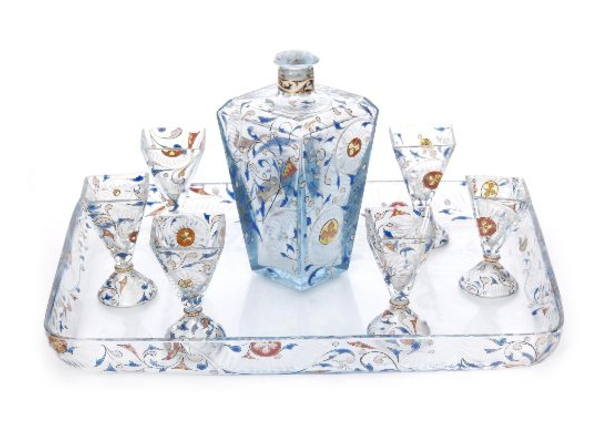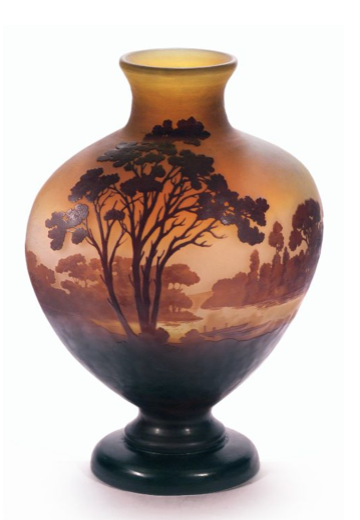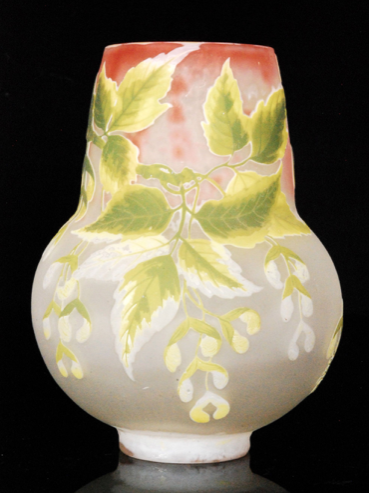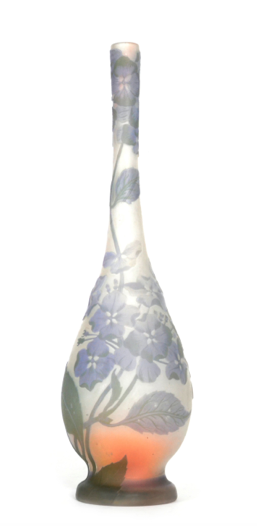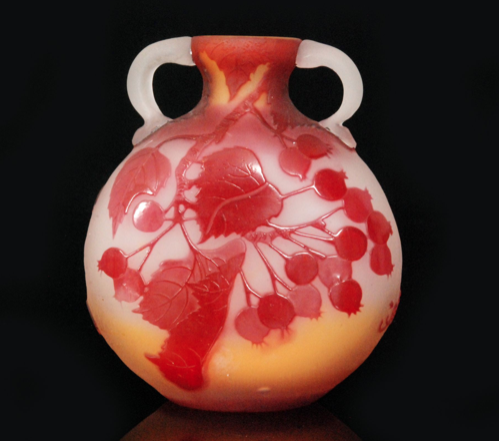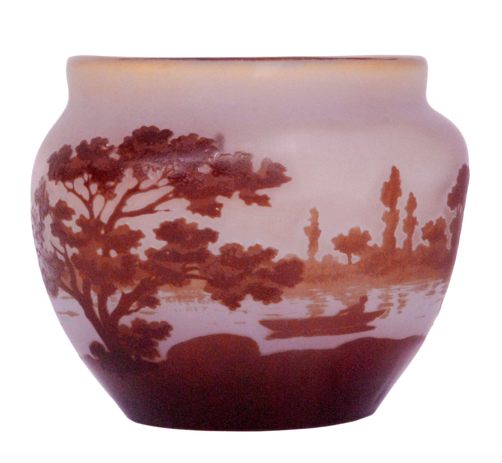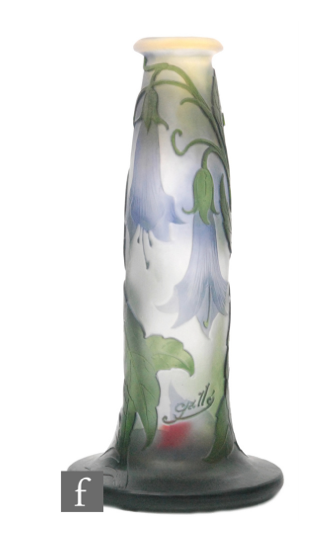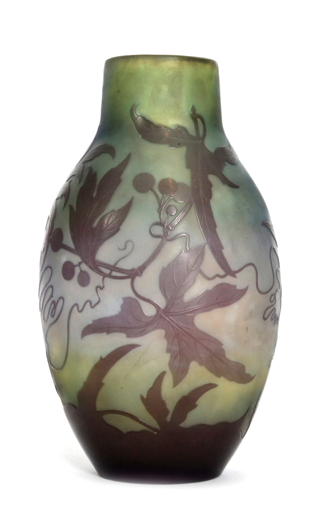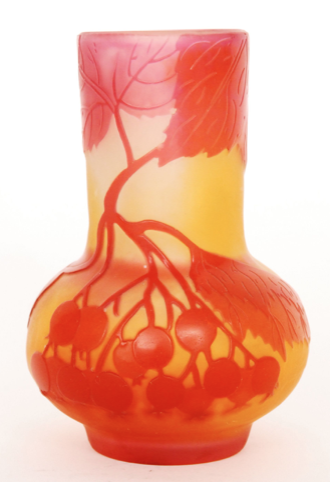Tutorial Tuesday - The Art of Emile Gallé
Poetry in Glass - The Art of Emile Gallé
Fieldings Auctioneers handle more glass than any other saleroom in the country and today our very own glass specialist and resident expert on the BBC's Antiques Roadshow Will Farmer takes a detailed look at the work of Emile Gallé, master of the glass makers art whose work today remains as popular and sought after as when it was first created.
I remember the day we first secured a piece of Gallé glass in for auction at Fieldings Auctioneers, I thought all my birthdays had come at once. Through college I had learned about his work and his prolific output, on visits to Paris I had seen exceptional examples of his work behind glass in the Musée d'Orsay, at the top antique fairs I'd seen and on occassion handled his glorious work usung the cameo glass technique but to have a piece consigned for sale was an absolute joy! That was nearly 20 years ago now and I have lost count of the number of pieces of Emile Galle Fieldings have now handled but its hundreds!
His work never fails to amaze me, he is a master of glass with an endless array of techniques from unique hand blown pieces to factory produced examples which bore his name the fundimental rule for his work was that it should be beautiful. Emile Gallé is considered to be one of the founding fathers behind the Art Nouveau movement. His naturalistic designs combined with innovative techniques made him one of the pioneering glass makers of the late 19th and early 20th century. Taking his inspiration from nature and plants combined with Japanese influenced design it is no wonder the French have been known to describe his work as “poetry in glass.”
Early beginnings.....
Born in the Eastern French town of Nancy in 1846 Emile Gallé was destined to become a glassmaker. His father, Charles Gallé was a successful ceramicist and traditional glassmaker with his own thriving factory. The young Emile Gallé began to learn the skills of the craftsman, painting pottery and helping to cut and enamel the glassware. After studying botany, chemistry, philosophy and art Gallé travelled extensively around Europe developing his knowledge of glassmaking by visiting museums and studying the work of other influential designers. He later went on to learn the technique of glassmaking at Meisenthal before joining his father at the factory in 1867.
He revolutionized the art of glass making by combining ancient techniques such as enamelling, cameo and inlay with his own influences and industrial innovations. Gallé's imagination and constant adoption of new techniques transformed glass making into a form unequalled to this day.
In 1873 he set up his own glass studio and eventually took over his father's glass and ceramics factory in 1877. His work began to be recognised both on home shores and internationally with a string of awards including the Grand Prix at the Paris Exhibition of 1878. However it was at the 1884 Union Centrale des Arts Décoratifs in Paris, where he truly made his mark exhibiting over 300 pieces of great artistic variety as well as technical expertise. This was a breakthrough for Gallé and the Art Nouveau style in general and soon his pieces began to be widely imitated. By 1891 his international fame was growing and Gallé only exhibited individual works at the major Paris salons where many were acquired by leading museums and collectors.
In 1894 Gallé built his own manufacturing plant in Nancy and throughout the 1890's created an astonishing array of pieces. The factory had over 300 employees which included a team of specialist craftsmen who worked on his designs only applying his signature after his approval.
Every piece created by his factory was heavily influenced by his passion of naturalistic designs. The plant life that adorns his pieces is varied and incorporates everything from the thistle to fuchsia, clematis and chrysanthemums. Insects were also a frequent theme; many of his pieces contain butterflies, dragonflies and even insects such as beetles. Another favoured decoration was that of landscapes, again Gallé looked to his surroundings for inspiration. He applied these decorative motifs to more than just vases producing a wide range of items including bowls, plaques and even table lamps
At the 1900 International Exhibition in Paris Gallé had an outstanding exhibition which included a working glass furnace in the centre of the display. The show was highly acclaimed, and Gallé won two top prizes. It was to be the final triumph of his career.
Determined to make Art Nouveau style known worldwide he founded the Ecole de Nancy to promote the Art Nouveau style and create a union between art and industry. Gallé remained the President of the School until his death in 1904. After Gallé’s death his widow managed the glassworks continuing the work of her late husband. All of the glass made after his death were marked with Gallé’s signature although a star was engraved alongside to indicate the pieces were produced after his death.
Production ceased with the outbreak of World War I and was not started again until after the war when Emile’s son-in-law took over the factory. Production ceased altogether in 1936 and no more authentic Gallé works have been created since.
His creative genius and vast body of work have created a legacy admired around the world. Collectors and academics alike hail Emile Gallé as one of the world’s greatest designers in the field of Art Nouveau and his work continues to enthral audiences over a hundred years after his death.
Top tips
So What Makes Gallé Glass So Valuable?
Gallé is viewed as one of the most collectable names in glass. Prices vary and while the most sensational and rare examples can realise into six figure sums a small piece can be acquired for as little as £200 or £300. At this price point you can secure a small cameo glass vase, typically decorated with flowers and foliage. These small bud vases are the perfect entry in to a broad collecting field which will grow with you as your knowledge grows.
Generally though his work is rare despite the fact he employed more than 300 people at one time. The hand crafted nature of the pieces led to low production resulting in pieces that are now hailed as safe investments in today’s market.
Fakes and forgeries!
Beware! There are fakes and forgeries which have made it onto the market in the last twenty or thirty years. Many reproductions marked Gallé have been made in central Europe and China and as a result some pieces have made their way into the antique fairs, auction rooms and online auction marketplace.
The key to identifying Gallé reproductions from is in the manufacture. Many newly made "Gallé" pieces are moulded glass, also known as pressed glass. This means the glass is not cut or etched or otherwise embellished to form the design, instead, the shapes that form the design are moulded into the glass.
Also in recent years there have been a number of reprduction pieces manufactured in Romania using better than average skills in glass making but also bearing relief carved cameo glass marks. In addition to the raised "Galle" mark, each piece carries a secondary mark, "TIP" which is the Romanian word for "type."In other words, "TIP" with "GALLE" means "Galle type."
When challenged at the time the importer said that TIP is included on the pieces to prevent any legal complications with a European group which claims the rights to the Galle name. The location of the TIP mark varies; some are close to the Galle, other marks are tucked away in parts of the design or pattern such as tree branches. The bigger problem in recent years is that some people have had the TIP mark removed by means of polishing to decieve a novice buyer. There are often signs where the mark has been polished out but its still prudent to be careful. Once you have handled genuine pieces the difference is easy to detect but its a word of caution for a new collector.
Another tip-off that a piece may be a cheap imitation is a low starting bid or asking price. While you may run across an authentic piece of Gallé at a bargain price some day and it's wise to know what to look for just in case you do, exceptionally low prices serve as a red flag that the piece in question may not be all it appears to be.
As with any area of collecting if you are considering investing in a piece of Gallé do your homework before buying. Invest in books, visit museums, go to vetted fairs and handle as many genuine examples as possible. Always buy from a reputable dealer or auction house that will stand behind their pieces. If you do buy through an online auction, be sure you can return the item if it turns out to be a fake.
Fieldings regularly handle examples of Emile Gallé's work and Will is always on hand to walk you through the patterns, techniques and designs of this outstanding glass maker. Fieldings Auctioneers hold regular specialist sales of glass so if you have a piece of Gallé you'd like to know more about or if you are interested in learning more about this wonderful designer contact Will Farmer via his email address will@fieldingsauctioneers.co.uk and he'll be delighted to share his love of this beautiful glass with you.
Shown in the images are just a small selection of works by Emille Gallé sold through Fieldings Auctioneers, for more examples please visit our sold results page and enter his name in to the search bar to see many more.
Posted on 21 April 2020
Be in the know
Sign up for auction email alerts so you never miss another sale at Fieldings!
Register now

